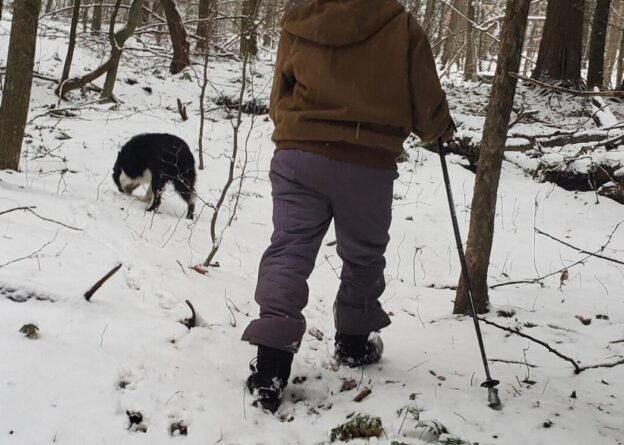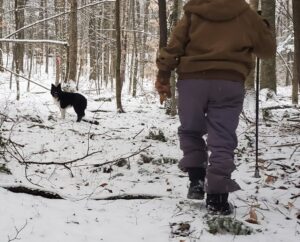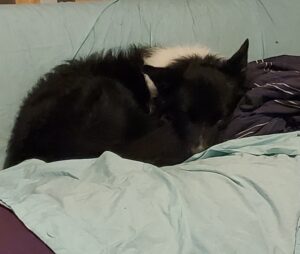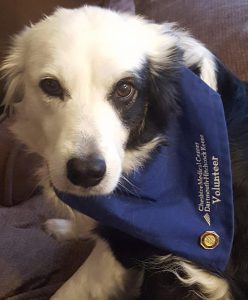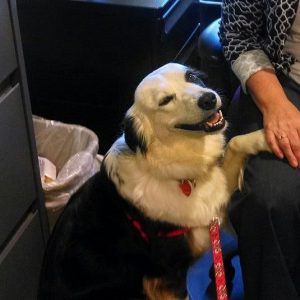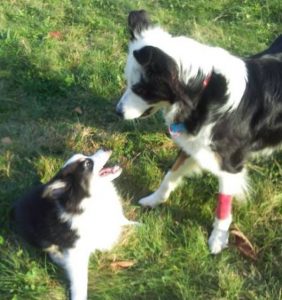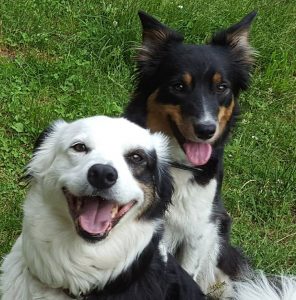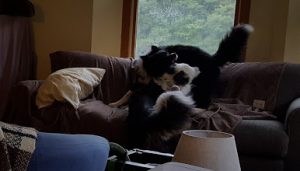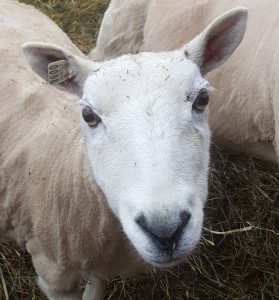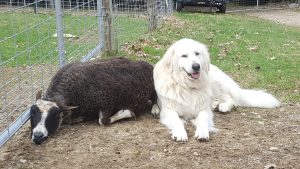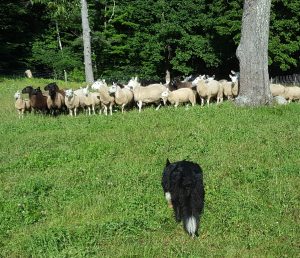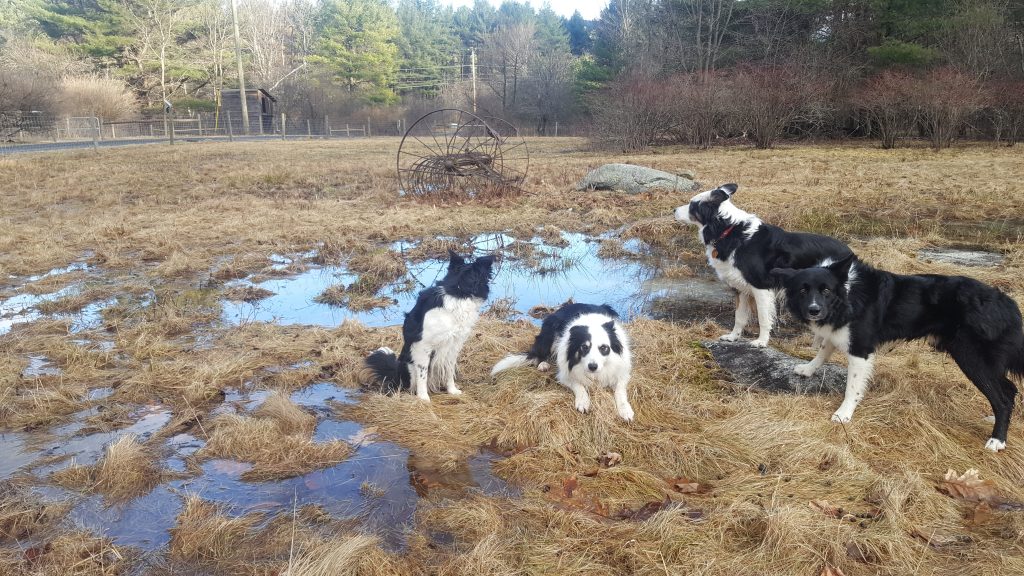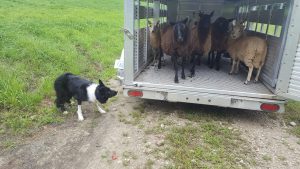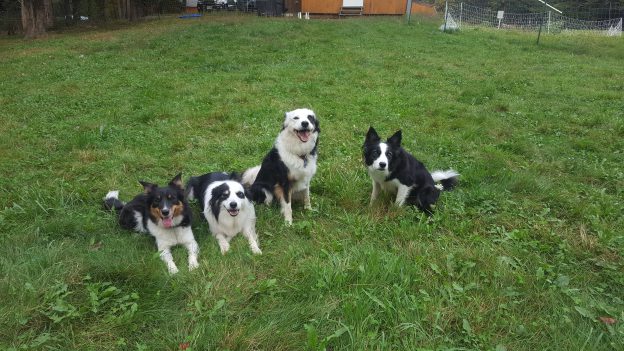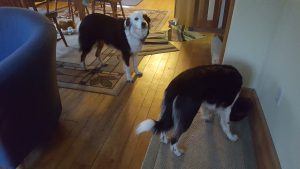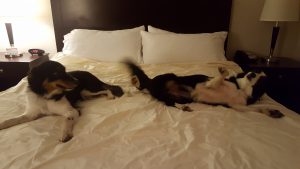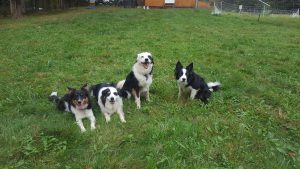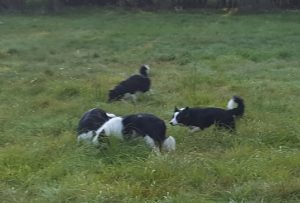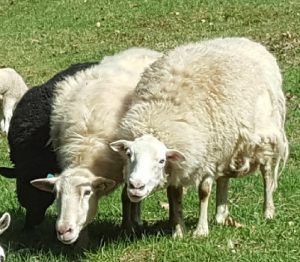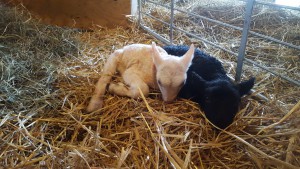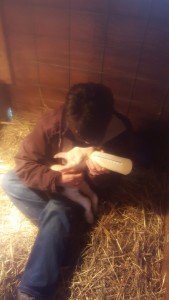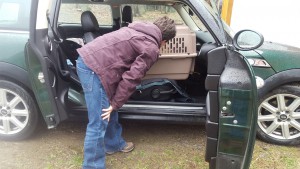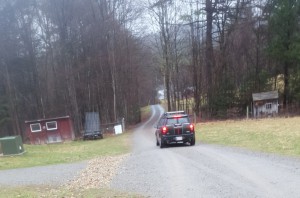As we stood discussing our plan of action at the place where the sheep tracks in the fresh snow left the logging road and went up a deer path, Poe’s nose hit the ground. He suddenly knew that our mission was not just a romp in the woods. It involved sheep. And he knew where they had headed.
The two elusive sheep have been living in these woods for 3 weeks. The terrain is rough. Hills, cliffs, swamps, old logging trails barely passable on a 4 wheeler. A sugar bush with sap lines criss crossing the woods. Spots of dense hemlock. Corrals and feeding stations have been set up. Many sightings and some almost successful cornering but still the sheep are not home.
But the new owners are persistent. They have learned the animal’s patterns and they know the woods like the back of their hands at this point.
I decided to assist on this quixotic quest knowing that it was unlikely to succeed but also knowing that if we got a clear opportunity that Poe would be the dog who could actually work to bring them home.
So Poe, having found their fresh scent took off down their trail, muttering under his breath at how slow the two leggeds go. I watched as my Border Collie did an imitation of a blood hound. And I thought about how Border Collies are bred not only to be biddable but to be able to work bringing sheep in from the hills on their own. To be able to be successful they have to be part tracker so it shouldn’t surprise me that a dog who is all about sheep should take naturally to this new job he created for himself. In the hills not only do they need to see the sheep but they need to use hearing and scent to detect the ones who are hiding. Because unlike our bucolic notions of sheep grazing on a grassy hillside, sheep left to their own devices know a thing or two about self-protection.
And so we followed him. It was easy to see he was right in the fresh dusting of snow. And when we crossed another path he would, like any self respecting tracking dog, check out the scents and make sure we were on the freshest one.
The sheep’s owners know the movement patterns of the sheep and they went off the head the sheep at their predicted route. Or one of their routes. The paths are more numerous than even the logging roads they frequent. More than once I found myself humming Loch Lomond. “Oh I’ll take the high road and you’ll take the low road”
Twice in our adventures, we saw the sheep, but at a distance where sending Poe (who most definitely alerted on them) would have more likely sent them deep into the woods or over a cliff. And more than once the sheep doubled back on us. The sheep knew we were there. The dog knew where the sheep were. Clearly a game of cat and mouse and the humans were the almost clueless ones.
It is hard to explain how difficult this terrain is. The hills and rock ledges, the fallen trees all make for a million places to hide and honestly it would be impossible to see the sheep if the leaves were on the trees.
Poe never quit his self-appointed tracking job. At one point he hopped off the logging road into the woods. ATV tracks had made it hard for us to see the sheep tracks. We called him back and kept up the hill another couple hundred feet only to find that Poe had been right and we were wrong.
As dusk began to arrive the sheep were headed toward a feeding corral and we had a brief moment of thinking that maybe we would catch them, if we got to the mouth soon enough. Two roads, a high one and a low one [Cue: Audio of Loch Lomond] lead to the corral. They had taken the low one.
We took the low road. Suddenly Poe alerted, looking up the hill. He had that look he has when he sees sheep and is ready for the out run. He stopped. He sat. He waited. He was trying to tell us something. I asked him if he saw the sheep and gazed into the cliff-like hill. I did not see anything though I suspected he was right. So we continued following the sheep tracks hoping they had entered the corral for a snack. But alas at the conjunction of the low road and the high road the sheep had done a 180, sensing a trap, and had headed back to their spot on the mountain. They must have chuckled as they passed us on that high road and looked down on us and the dog. Poe had known all along.
The sheep know the terrain. They basically lived wild in a pasture for the last few years. So they are used to taking care of themselves and see little use for humans, don’t understand what grain is (shake it in a bucket and they run away). They have developed habits, which as the new owners discern them will help with an eventual capture, but their habits are smart. Poe’s actions yesterday helped them see the pattern that the sheep always take the high road to double back when they feel pressure from the hunt. Sheep gravitate to high spots where they have the visual and physical advantage (face it, humans do too – we build our fortresses high). They can see the predators better than the predators can see them and predators have to overcome the extra effort to go up hill.
As we were chatting last night about lessons learned and the additional information gathered, I made some comment about how people think sheep are dumb and it is so clear that these sheep are not. They are exquisitely tuned into their environment and have learned had to navigate it and use it to their advantage. The owner made a remark about how easy it is to fool her goat.
And it hit me. We think animals are stupid. But we also make animals stupid either by breeding in stupidity or never letting them develop their intellectual capacities.
The goat has lived inside a fence all his life. He has people feed him and water him and clean up his poop. People aren’t really his predators and so he can be easily fooled.
By contrast, these sheep are smart. As prey animals they are attuned to what makes them safe. We don’t think they are being smart because we can offer them a safe secure barn, unlimited food and an almost guarantee that predators won’t get them. But they recognize us for what we are – predators. They have probably been having private chats with the deer. Though maybe they understand humans better than deer because they have had more contact.
And Poe. I never thought much about tracking with a Border Collie. I know that search and rescue use them often. So it is no surprise. Certainly it would be a fundamental characteristic that would be required to bring sheep out of the hills of Scotland and the Lake District. His intellect frequently amazes me. He is highly motivated to learn everything he possibly can in order to do what he loves – work sheep. If it takes tracking the sheep on his own (which he probably has done way more than I am aware of in the past) then he is going to do it. He has the nose and the ears for it.
I thought about my sheep. They aren’t accustomed to navigating the wilds of Northern Vermont. They would be drawn towards the people and would be quickly recaptured. We would think they were “smart” because of that. Because humans have such a narrow view of what is smart and safe…
So I spent a day in the woods traipsing after two wiley sheep. I really didn’t expect for us to have a moment when Poe could shine as a sheep dog. It seemed a very, very long shot. And we weren’t successful. I am not sure why I volunteered except I needed a change of scenery. I rarely regret such adventures because they make my brain think even if the outward signs were of failure.
It gave me much to contemplate. I think about pet dogs and how barren their lives are. They don’t grow up with infinite learning possibilities or often opportunities to employ and develop their natural talents. Like the goat, they seem easily fooled to us. We think of them as dumb by our standards but we don’t allow them the opportunity to learn and grow and show us how smart they can be. Or we teach them things that we think are important or amuse us. It applies to humans as well I suspect. Everytime I see a working dog in its element (or in this case wild sheep in theirs), I am given pause at how extraordinarily well tuned they are to their world.
Sheep dog training and trialing is an exercise in humility. Our dogs can exceed our expectations if we let them – and often we don’t fully appreciate their knowledge because it is of a different sort than ours. We often call it instinct. But it is instinct and experience. That creates knowledge. Over the years, I can not tell you how many times I have muttered under my breath (or had a teacher mumble in my ear) “the dog was right” when I made a hash of something.
Yesterday when Poe put his nose to that trail, the words of more than one experienced handler rang in my ears “Trust your dog” and so I did. And he was right. Our slogging two leggedness was a hindrance to success.
And in that moment when the sheep were laughing from up on their hill and Poe was telling me they were up there, I only thought “he’s right”, but *I* don’t have enough information about the terrain up there or enough visual information to send him on a blind gather.
I chose not to take a risk – with my dog or the sheep who could panic near the edge of a very sharp drop. It was the right choice.
But if I knew what Poe knew I might have done things differently.

